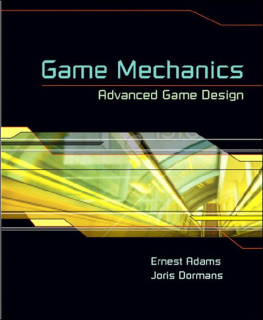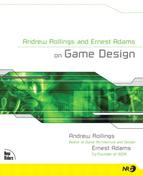Fundamentals of Game Design
You understand the basic concepts of game design: gameplay, user interfaces, core mechanics, character design, and storytelling. Now you want to know how to apply them to individual game genres. These focused guides give you exactly what you need. They walk you through the process of designing for game genres and show you how to use the right techniques to create fun and challenging experiences for your players.
Fundamentals of Music, Dance, and Exercise Game Design
Fundamentals of Role-Playing Game Design
Fundamentals of Vehicle Simulation Design
Fundamentals of Adventure Game Design
Fundamentals of Action and Arcade Game Design
For a complete listing visit peachpit.com/ernestadams
Introduction
This book defines adventure games and covers the history and evolution of these games from text-based to todays hybrids. Well explore the features common to adventure games and the gameplay mechanics that define the genre in depth. Well cover puzzle structure, game flow, dialogue, and language, all of which form integral parts of the adventure game. This book finishes with a discussion of the art and user interface that is unique to this genre.
What Are Adventure Games?
Many video games dont need a story, but in adventure games, the story is the point, the main reason people play. As the designer of an adventure game, its your job to bring a world to lifea world in which a story is taking place. Your talents at creating places, characters, plots, dialogue, and puzzles will be tested as in no other genre. Because the adventure game is not limited by flying or shooting or commanding troops in battleindeed, it isnt bound by any particular mode of interactionit has the greatest potential for creativity of any genre.
Adventure games are quite different from most other games on the market. An adventure game isnt a competition or a simulation. An adventure game doesnt offer a process to manage or an opponent to defeat through strategy and tactics. Instead, an adventure game is an interactive story about a character. This character is the players avatar, but hes more than merely a representative of the player. He is a fictional person in his own right, a protagonist, the hero of the story.
Adventure Games
Adventure games are interactive stories about a protagonist character who is played by the player. Storytelling and exploration are essential elements of the game. Puzzle solving and conceptual challenges make up the majority of the gameplay. Combat, economic management, and action challenges are reduced or nonexistent.
This definition doesnt mean that there is no conflict in adventure games (although many adventure games have none)only that combat is not a primary activity. Adventure games seldom have an internal economy. All the relationships within the game are symbolic rather than numeric. Manipulating or optimizing an economic system forms no part of the adventure game experience; this (among other things) sets them apart from role-playing games.
Why Adventure Games?
The term adventure game is a bit misleading because a lot of games about being adventurous arent adventure gamesand a lot of adventure games arent about adventures, at least in the fairy-tale sense of going forth to seek ones fortune. The reason for the term is historical. Adventure game is really short for Adventure-type game, meaning a game similar to the one named Adventure (sometimes referred to as Colossal Cave). All adventure games are conceptual descendants of the original Adventure, although nowadays they include many features that Adventure lacked.
The History of Adventure Games
Adventure games have changed more over their history than other game genres have. Sports, driving, and fighting games, for example, have better graphics than in the past, but their gameplay seldom changes much because these are well-understood fantasies. Because adventure games are not about any one subject or activity, there is considerable variation among them. In this section, well look at the history of adventure games.
The Early Days
Adventure games were highly popular in the early days of personal computers. The first ones were text-only, which made them inexpensive to develop and allowed great scope for both the designers and the players imaginations. A group of students at MIT, inspired by the original Adventure, wrote a much larger adventure game named Zork on the mainframe there. Soon afterward, they converted it to run on personal computers and founded a company, Infocom, devoted to developing text adventures. Infocom published games about all kinds of things: fantasy magic, film noir detective stories, exploration of an ancient Egyptian pyramid, and so on.
The original Adventure didnt have any plot; it just offered a space to explore and puzzles to solve. With minor exceptions, its world did not change as time passed. But it wasnt long before games began to explore the notion of interactive storytelling, which Fundamentals of Game Design, Third Edition discusses in detail.
Text-only adventure games have long ceased to be a commercial market, but they live on as an art form for enthusiasts who are interested in the power of the written word in gaming. This field is now called interactive fiction, and a number of free tools exist to help people create such works. If you would like to learn more about it, see the Wikipedia entry on interactive fiction, which includes links to some of the more popular development tools.
Graphics Change Everything
As soon as personal computers began to develop graphics capability (the very earliest were text-only), developers started to add graphics to adventure games, and the games really took off. LucasArts and Sierra On-Line dominated the genre; and from the mid-1980s to the early 90s, they produced the best-looking, richest games on the market: funny, scary, mysterious, and fascinating. Adventure games provided challenges and explored areas that other genres didnt touch. Myst, a point-and-click graphic adventure, was for many years the best-selling personal computer game of all time. (It was later supplanted by The Sims.)
The first graphical adventure games came with gorgeously painted but static backdrops for every scene that looked much like theatrical stage sets. Players could see a lot of things but could touch only a few of them. Although the arrival of 3D acceleration hardware in the early 1990s made it possible to create new kinds of adventure games, its primary use was for vehicle simulations, first-person shooters (FPSs), and other, more action-oriented genres. Adventure games lost their grip on the publics imagination, as well as their overall share of the video game market, throughout the 90s. But they continued to be made for people who really like them, especially in Germany.
Action-Adventures
The arrival of 3D hardware also gave rise to a new sort of game, a hybrid of action game and adventure game called, unsurprisingly, an

![Ernest Adams [Ernest Adams] Fundamentals of Adventure Game Design](/uploads/posts/book/119415/thumbs/ernest-adams-ernest-adams-fundamentals-of.jpg)





![Ethan Ham [Ethan Ham] - Tabletop Game Design for Video Game Designers](/uploads/posts/book/119417/thumbs/ethan-ham-ethan-ham-tabletop-game-design-for.jpg)





